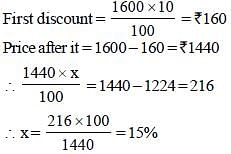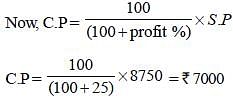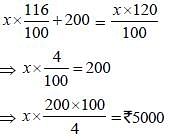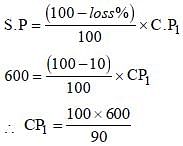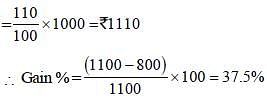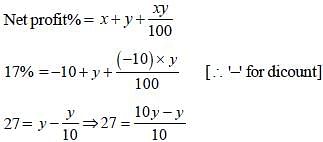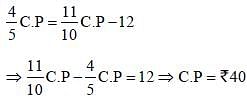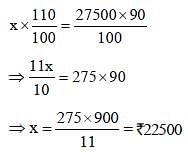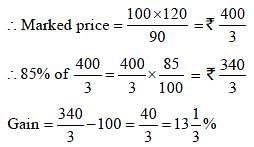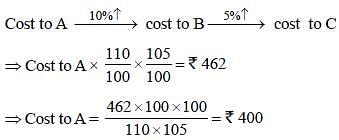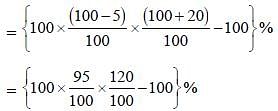SSC CGL Previous Year Questions: Profit & Loss - 4 - SSC CGL MCQ
30 Questions MCQ Test - SSC CGL Previous Year Questions: Profit & Loss - 4
On selling an article for ₹ 170, a shopkeeper loses 15%. In order to gain 20%, he must sell that article at rupees : (SSC CGL 1st Sit. 2013)
Which of the following successive discounts is better to a customer? (SSC CGL 1st Sit. 2013)
(A) 20%, 15%, 10% or (B) 25%, 12%, 8%
(A) 20%, 15%, 10% or (B) 25%, 12%, 8%
| 1 Crore+ students have signed up on EduRev. Have you? Download the App |
The marked price of a mixie is ₹ 1600. The shopkeeper gives successive discount of 10% and x% to the customer. If the customer pays ₹1224 for the mixie, find the value of x : (SSC CGL 1st Sit. 2013)
A shopkeeper marks the price of an article at ₹ 80. What will be the selling price, if he allows two successive discounts at 5% each? (SSC CGL 1st Sit. 2013)
If books bought at prices ranging from ₹ 150 to ₹ 300 are sold at prices ranging from ₹ 250 to ₹ 350, what is the greatest possible profit that might be made in selling 15 books? (SSC CHSL 2013)
The cost price of a book is ₹ 150. At what price should it be sold to gain 20%? (SSC CHSL 2013)
A got 30% concession on the label price of an article sold for ₹ 8,750 with 25% profit on the price he bought. The label price was (SSC CHSL 2013)
A shopkeeper blends two varieties of tea costing ₹ 18 and ₹ 13 per 100 gm in the ratio 7:3. He sells the blended variety at the rate of ₹ 18.15 per 100 gm. His percentage gain in the transaction is (SSC CHSL 2013)
An article was sold at 16% gain. Had it been sold for ₹ 200 more, the gain would have been 20%. Then the cost price of the article is : (SSC Sub. Ins. 2013)
A man sold 250 chairs and had a gain equal to selling price of 50 chairs. His profit per cent is: (SSC Sub. Ins. 2013)
By selling a fan for ₹ 600, a man loses 10%. To make a gain of 20%, the selling price of the fan should be (SSC Multitasking 2013)
The cost price of a radio is ₹ 600. 5% of the cost price is charged towards transportation. After adding that, if the net profit to be made is 15%, then the selling price of the radio must be (SSC Multitasking 2013)
A dishonest grocer sells rice at a profit of 10% and also uses weights which are 20% less than the marked weight. The total gain earned by him will be (SSC Multitasking 2013)
A merchant allows a discount of 10% on marked price for the cash payment. To make a profit of 17%, he must mark his goods higher than their cost price by (SSC Multitasking 2013)
Two successive discounts of 70% and 30% are equivalent to a single discount is (SSC Multitasking 2013)
A merchant purchases a wrist watch for ₹ 450 and fixes its list price in such a way that after allowing a discount of 10%, he earns a profit of 20%. Then the list price of the watch is (SSC Multitasking 2013)
A trader has a weighing balance that shows 1,200 gm for a kilogram. He further marks up his cost price by 10%. Then the net profit percentage is (SSC CGL 2nd Sit. 2012)
A man sold an article at a loss of 20%. If he sells the article for ₹ 12 more, he would have gained 10%. The cost price of the article is (SSC CGL 2nd Sit. 2012)
A businessman allows a discount of 10% on the written price. How much above the cost price must he mark his goods to make a profit of 17%? (SSC CGL 2nf Sit. 2012)
A man makes a profit of 20% on the sale by selling 20 articles for ₹1. The number of articles he bought by ₹1 (SSC CGL 2nd Sit. 2012)
A dealer offered a machine for sale for ₹27,500 but even if he had charged 10% less, he would have made a profit of 10%. The actual cost of the machine is (SSC CGL 2nd Sit. 2012)
By selling 9 articles for a rupee, a man incurred a loss of 4%. To make a gain of 44%, the number of articles to be sold for a rupee is: (SSC CGL 1st Sit. 2012)
If a commission of 10% is given on the marked price of a work, the publisher gains 20%. If the commission is increased to 15%, the gain percent is: (SSC CGL 1st Sit. 2012)
A watch is sold at a profit of 30%. Had it been sold for ₹ 80 less, there would have been a loss of 10%. What is the cost price of rupees? (SSC CGL 1st Sit. 2012)
'A' sells an article to 'B' at a profit of 20% and 'B' sells it to 'C' at a profit of 25%. If 'C' pays ₹1200, the cost price of the article originally (in ₹) is (SSC CGL 1st Sit. 2012)
A discount of 30% on the marked price of a toy reduces its selling price by ₹30. What is the new selling price (in ₹)? (SSC CGL 1st Sit. 2012)
A sells an article to B at a gain of 10%, B sells it to C at a gain of 5%. If C pays ₹462 for it, what did it cost to A? (SSC CHSL 2012)
The printed price of a book is ₹ 320. A retailer pays ₹ 244.80 for it. He gets successive discounts of 10% and an another rate. His second rate is : (SSC CHSL 2012)
The profit percent of a bookseller if he sells book at marked price after enjoying a commission of 25% on marked price will be: (SSC CHSL 2012)
A bought an article, paying 5% less than the original price. A sold it with 20% profit on the price he had paid. What percent of profit did A earn on the original price ? (SSC CHSL 2012)







